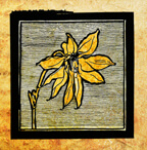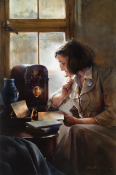Wherefore, ye must press forward with a steadfastness in Christ, having a perfect brightness of hope, and a love of God and of all men...
The story behind Brightness Of Hope
In the midst of the physical and emotional darkness of the Occupation, Lucile stood out and spoke up at the risk of her own life and happiness. From before the war, Lucile had been serving in the Paris presidency of the Relief Society of The Church of Jesus Christ of Latter-day Saints (an organization of women) and she refused to hide her light under the Nazi regime, despite the innate danger to herself. Lucile wrote: I was known in the neighborhood as "the mouthpiece of occupied France" because, outside my other efforts [in the Resistance], I listened to every BBC broadcast, I lifted the spirits of the hopeless, who had no radios, and spread such encouraging words that came to us across the waves which I will never forget. I cannot lay out every detail of my activity—tract distribution, etc.—I only did the work of a great patriot who loves her dear Motherland and who holds a great gratitude toward the Allies who did so much for France (Fabres, Louise, Questionnaire, 5 March 1946, translated by Grant Emery).
As the war continued, Lucile was not content to bless through spoken and printed word alone. Her bravery extended to the field as well. She began to receive a growing number of assignments from the Resistance. True to her commission as a Relief Society sister to minister with love and charity, Lucile's contributions to the war effort were always acts of mercy, such as hiding allied parachutists, caring for the injured, and tracing the launch sites of V1-bombs in the hope of saving lives. A nurse by profession, she was ever true to her commission to heal broken bodies and soothe wounded souls. Her courage earned her Croix de Lorraine in 1944 and recognition by the British and Canadian governments, though her only desire for decoration was to wear a modest tricolor ribbon as reminder of the kindness of those selfless soldiers who fought to liberate her native country.
Symbolism in Brightness Of Hope
The artist also chose a 1930s-style American radio for her painting to symbolize Lucile's connection with the American missionaries of the Church of Jesus Christ of Latter-day Saints, who first shared with her the light of the gospel of Jesus Christ in 1937 and brought brightness of hope to her personal wilderness. The radio also connects Lucile's service to the Allied troops fighting for her freedom.
In the lapel of her summer suit, Lucile wears a small chicory blossom. During WWII, Parisians often used chicory root to replace coffee beans for their morning beverage. While Lucile's religious beliefs dictated abstinence from tea or coffee, the small blossom reminds the viewer of the strict rationing imposed on Parisians by the Nazi regime. In the language of flowers, chicory symbolizes frugality—a quality she employed in her wartime service as well as her post-war efforts as president of the local Relief Society.
Beside the radio on her desk, the artist painted objects typical of a Parisian apartment of her day. The small daybook is open to the week of August, 23, 1944, when the Allies liberated Paris. While Lucile did not know the ending of her War, hope gave her the ability to see the end from the beginning (see Abraham 2:8), assured of the promises afar off (see Hebrews 11:13). An overcoat draped over the chair at the bottom left of the painting, ready to put on at a moment's notice, indicates the hurried pace of Lucile's life as an undercover agent for the Resistance.
Copyright and terms of use
© By Elspeth Young, All Rights Reserved. You may not print, copy, or reproduce this artwork or make derivative works from it without the prior written consent of the copyright holder. For permissions, please review our FAQ page.From the Newsroom

By Al R. Young
only high-end custom frames
We have framed our own artworks for more than 30 years, and during that time we have provided a variety of framing services to patrons upon request. For many reasons—including constant changes in the availability of moulding styles—we cannot offer off-the-shelf framing options or response times typically associated with such a service. Of necessity, all of our framing projects are aproached, priced, and billed as constuling projects... Read more »
Tags: Into The West, Spring Rain, North Country, The Grey Havens, Journey's End, Looking Back, Enchanted Stillness, Bedtime Story, In The High Valley, The Daydream, Before The Ball, Old Shannon, Pavane, Sweet Brier, Legend, Mountain Home, And I...

By Al R. Young Brightness Of Hope is the newest oil painting to be added to the line of original artworks from Al Young Studios.
Click here to see a larger image of the new painting, read the artist's commentary, and look at the selection of prints--if any are available.... Read more »
Tags: Brightness Of Hope, 2020, Elspeth C. Young, Legacy, News, Oil paintings and prints, Pioneer Art Collection